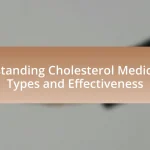Cholesterol medications, particularly statins, play a crucial role in managing cholesterol levels and reducing cardiovascular risks in older adults. This article evaluates the purpose, mechanisms, and types of cholesterol medications, highlighting their effectiveness in lowering low-density lipoprotein (LDL) cholesterol and preventing heart attacks and strokes. It also addresses the common reasons for prescribing these medications, the potential risks and side effects, and the impact of age on cholesterol levels and cardiovascular health. Additionally, the article discusses best practices for managing cholesterol, including lifestyle changes and the importance of patient education in optimizing treatment outcomes for older adults.

What are Cholesterol Medications and Their Purpose in Older Adults?
Cholesterol medications, primarily statins, are used in older adults to lower low-density lipoprotein (LDL) cholesterol levels, thereby reducing the risk of cardiovascular diseases such as heart attacks and strokes. Statins have been shown to decrease the incidence of major cardiovascular events by approximately 25-30% in older populations, according to studies published in the Journal of the American College of Cardiology. These medications help manage cholesterol levels effectively, which is crucial as older adults often experience increased cholesterol levels and a higher risk of cardiovascular complications.
How do cholesterol medications work in the body?
Cholesterol medications primarily work by lowering levels of low-density lipoprotein (LDL) cholesterol in the bloodstream. Statins, the most commonly prescribed cholesterol medications, inhibit the enzyme HMG-CoA reductase, which plays a crucial role in cholesterol synthesis in the liver. This reduction in cholesterol production leads to an increase in the liver’s uptake of LDL cholesterol from the blood, thereby lowering overall LDL levels. Clinical studies have shown that statins can reduce the risk of cardiovascular events by approximately 25-30% in high-risk populations, demonstrating their effectiveness in managing cholesterol levels and improving heart health.
What are the different types of cholesterol medications available?
The different types of cholesterol medications available include statins, bile acid sequestrants, cholesterol absorption inhibitors, fibrates, and PCSK9 inhibitors. Statins, such as atorvastatin and simvastatin, are the most commonly prescribed and work by reducing the liver’s production of cholesterol. Bile acid sequestrants, like cholestyramine, bind bile acids in the intestine, leading to decreased cholesterol levels. Cholesterol absorption inhibitors, such as ezetimibe, prevent the absorption of cholesterol from the diet. Fibrates, including fenofibrate, primarily lower triglyceride levels and can modestly increase HDL cholesterol. Lastly, PCSK9 inhibitors, like alirocumab, are newer medications that significantly lower LDL cholesterol by enhancing the liver’s ability to remove it from the bloodstream. These medications are supported by clinical guidelines and studies demonstrating their efficacy in managing cholesterol levels and reducing cardiovascular risk.
How do these medications affect cholesterol levels?
Cholesterol medications, particularly statins, primarily lower low-density lipoprotein (LDL) cholesterol levels in the bloodstream. Statins inhibit the enzyme HMG-CoA reductase, which plays a crucial role in cholesterol synthesis in the liver, leading to a significant reduction in LDL cholesterol levels by approximately 20% to 60%, depending on the specific medication and dosage. Additionally, some cholesterol medications, such as ezetimibe, work by reducing the absorption of cholesterol from the diet, further contributing to lower cholesterol levels. Clinical studies, including the JUPITER trial, have demonstrated that statin therapy effectively reduces cardiovascular events by lowering LDL cholesterol, thereby validating their role in managing cholesterol levels in older adults.
What are the common reasons for prescribing cholesterol medications to older adults?
Cholesterol medications are commonly prescribed to older adults primarily to reduce the risk of cardiovascular diseases, including heart attacks and strokes. As individuals age, they often experience elevated cholesterol levels, which can lead to atherosclerosis, a condition characterized by the buildup of plaques in the arteries. Statistically, older adults with high LDL cholesterol levels have a significantly increased risk of cardiovascular events; for instance, studies indicate that lowering LDL cholesterol by 1% can reduce the risk of heart disease by approximately 1%. Additionally, older adults may have comorbid conditions such as diabetes or hypertension, which further necessitate the use of cholesterol-lowering medications to manage overall cardiovascular risk effectively.
How does age influence cholesterol levels and cardiovascular risk?
Age significantly influences cholesterol levels and cardiovascular risk, as older adults typically experience increased levels of low-density lipoprotein (LDL) cholesterol and decreased levels of high-density lipoprotein (HDL) cholesterol. This shift in cholesterol profiles contributes to a higher risk of cardiovascular diseases, including heart attacks and strokes. Research indicates that individuals aged 65 and older have a 50% higher prevalence of high cholesterol compared to younger populations, which correlates with an increased incidence of cardiovascular events. Additionally, age-related changes in metabolism and hormonal levels further exacerbate these risks, making it crucial to monitor and manage cholesterol levels in older adults to mitigate cardiovascular complications.
What specific health conditions in older adults necessitate cholesterol medication?
Older adults with specific health conditions such as cardiovascular disease, diabetes, and a history of stroke often necessitate cholesterol medication. These conditions are associated with elevated cholesterol levels, which increase the risk of heart attacks and other cardiovascular events. For instance, individuals with cardiovascular disease have a higher likelihood of experiencing adverse outcomes if their cholesterol levels remain unmanaged, as supported by studies indicating that statin therapy can reduce cardiovascular events by approximately 25% in this population. Additionally, older adults with diabetes are at an increased risk for heart disease, making cholesterol-lowering medications essential for managing their overall health.

What are the Potential Risks Associated with Cholesterol Medications in Older Adults?
Cholesterol medications, particularly statins, pose several potential risks for older adults, including muscle pain, cognitive impairment, and increased risk of diabetes. Studies indicate that muscle-related side effects occur in approximately 10% of older adults taking statins, leading to discomfort and reduced physical activity. Cognitive issues, such as memory loss or confusion, have also been reported, although the evidence remains inconclusive. Furthermore, research shows that older adults on statins may have a 30% higher risk of developing type 2 diabetes compared to those not on these medications. These risks necessitate careful evaluation of the benefits versus potential adverse effects when prescribing cholesterol medications to older populations.
What side effects are commonly reported by older adults taking cholesterol medications?
Common side effects reported by older adults taking cholesterol medications include muscle pain, fatigue, and gastrointestinal issues such as nausea and diarrhea. Research indicates that statins, a common class of cholesterol-lowering drugs, can lead to muscle-related side effects in approximately 10-15% of users, particularly in older populations. Additionally, older adults may experience an increased risk of cognitive impairment and liver enzyme abnormalities while on these medications. These findings are supported by studies published in journals such as the Journal of the American College of Cardiology, which highlight the prevalence of these side effects in older patients.
How do these side effects impact the quality of life for older adults?
Side effects from cholesterol medications significantly impact the quality of life for older adults by causing discomfort and limiting daily activities. Common side effects such as muscle pain, fatigue, and gastrointestinal issues can lead to decreased physical mobility and increased dependency on caregivers. Research indicates that approximately 10-20% of older adults experience these adverse effects, which can result in reduced adherence to medication regimens and a decline in overall health status. Consequently, the presence of these side effects can lead to increased feelings of isolation and depression among older adults, further diminishing their quality of life.
What are the long-term risks of using cholesterol medications in this age group?
Long-term risks of using cholesterol medications in older adults include muscle pain, liver damage, and an increased risk of diabetes. Statins, a common class of cholesterol medications, have been associated with myopathy and rhabdomyolysis, which can lead to severe muscle damage. Additionally, studies indicate that statin use may elevate liver enzyme levels, suggesting potential liver injury. Furthermore, research published in the Journal of the American College of Cardiology found that older adults on statins have a higher incidence of new-onset diabetes, with a relative risk increase of approximately 9%. These risks necessitate careful monitoring and consideration of individual patient factors when prescribing cholesterol medications to older adults.
How can drug interactions affect older adults on cholesterol medications?
Drug interactions can significantly affect older adults on cholesterol medications by increasing the risk of adverse effects and reducing the effectiveness of treatment. Older adults often take multiple medications, which raises the likelihood of interactions that can lead to complications such as muscle pain, liver damage, or increased risk of bleeding. For instance, statins, commonly prescribed for cholesterol management, can interact with medications like certain antibiotics or antifungals, leading to elevated statin levels in the blood and heightened side effects. Studies indicate that approximately 50% of older adults are on polypharmacy, which underscores the importance of careful medication management to mitigate these risks.
What medications commonly interact with cholesterol medications?
Medications that commonly interact with cholesterol medications include certain antibiotics, antifungals, and other lipid-lowering agents. For example, erythromycin and azole antifungals like ketoconazole can increase the levels of statins, leading to a higher risk of side effects such as muscle damage. Additionally, fibrates, when used with statins, can also elevate the risk of myopathy. These interactions are significant as they can alter the effectiveness and safety profile of cholesterol medications, necessitating careful monitoring and potential dosage adjustments.
How can healthcare providers mitigate these interactions?
Healthcare providers can mitigate interactions related to cholesterol medications in older adults by conducting comprehensive medication reviews and monitoring patient adherence. By regularly assessing all medications a patient is taking, providers can identify potential drug-drug interactions and adjust prescriptions accordingly. Studies indicate that older adults often take multiple medications, increasing the risk of adverse interactions; thus, a proactive approach in medication management is essential. Additionally, educating patients about the importance of reporting all medications, including over-the-counter drugs and supplements, further enhances safety and efficacy in treatment plans.

What are the Benefits of Cholesterol Medications for Older Adults?
Cholesterol medications provide significant benefits for older adults by reducing the risk of cardiovascular diseases. These medications, particularly statins, have been shown to lower LDL cholesterol levels, which is directly linked to a decreased incidence of heart attacks and strokes. A study published in the Journal of the American College of Cardiology found that statin therapy in older adults can reduce the risk of major cardiovascular events by approximately 25% to 30%. Additionally, cholesterol medications can improve overall heart health, enhance quality of life, and potentially extend lifespan by managing cholesterol levels effectively.
How do cholesterol medications contribute to cardiovascular health in older adults?
Cholesterol medications, particularly statins, contribute to cardiovascular health in older adults by effectively lowering low-density lipoprotein (LDL) cholesterol levels, which reduces the risk of heart disease and stroke. Statins have been shown to decrease the incidence of major cardiovascular events by approximately 25-30% in individuals over 65 years of age, according to a meta-analysis published in the Journal of the American College of Cardiology. Additionally, these medications can stabilize atherosclerotic plaques, further preventing cardiovascular complications.
What evidence supports the effectiveness of these medications in reducing heart disease risk?
Cholesterol medications, particularly statins, have demonstrated effectiveness in reducing heart disease risk. Clinical trials, such as the JUPITER trial, showed that statin therapy significantly lowered the incidence of major cardiovascular events by 44% in individuals with elevated C-reactive protein levels, regardless of baseline cholesterol levels. Additionally, meta-analyses, including data from over 170,000 participants, confirmed that statins reduce the risk of heart attacks and strokes by approximately 25% to 30%. These findings provide robust evidence supporting the use of cholesterol medications in mitigating heart disease risk among older adults.
How do cholesterol medications improve overall health outcomes for older adults?
Cholesterol medications, particularly statins, improve overall health outcomes for older adults by significantly reducing the risk of cardiovascular events such as heart attacks and strokes. Clinical studies, including a meta-analysis published in the Journal of the American College of Cardiology, have shown that statin therapy can lower LDL cholesterol levels by 30-50%, which correlates with a 20-30% reduction in major cardiovascular events in older populations. Additionally, these medications can stabilize atherosclerotic plaques, reducing the likelihood of plaque rupture and subsequent cardiovascular complications. Thus, cholesterol medications play a crucial role in enhancing longevity and quality of life for older adults by mitigating cardiovascular risks.
What lifestyle changes can enhance the benefits of cholesterol medications?
Adopting a heart-healthy lifestyle can significantly enhance the benefits of cholesterol medications. Key changes include following a balanced diet rich in fruits, vegetables, whole grains, and healthy fats, which can lower LDL cholesterol levels and improve overall heart health. Regular physical activity, such as at least 150 minutes of moderate exercise per week, has been shown to raise HDL cholesterol and lower triglycerides. Additionally, maintaining a healthy weight can further improve cholesterol levels and reduce cardiovascular risk. Quitting smoking and limiting alcohol intake also contribute to better outcomes with cholesterol medications. Studies indicate that these lifestyle modifications can lead to a 10-20% reduction in LDL cholesterol, thereby amplifying the effectiveness of prescribed medications.
How does diet play a role in managing cholesterol levels alongside medication?
Diet significantly influences cholesterol levels and can enhance the effectiveness of medication. A diet low in saturated fats and trans fats, while rich in fruits, vegetables, whole grains, and healthy fats, can lower LDL cholesterol and improve overall heart health. For instance, the American Heart Association recommends incorporating foods high in soluble fiber, such as oats and beans, which can reduce cholesterol absorption in the bloodstream. Studies indicate that dietary changes can lead to a reduction in LDL cholesterol by 5-10%, complementing the effects of statin medications, which typically lower LDL by 20-50%. Thus, a balanced diet not only supports medication but also plays a crucial role in overall cholesterol management.
What exercise recommendations are beneficial for older adults on cholesterol medications?
Older adults on cholesterol medications should engage in regular aerobic exercise, such as walking, swimming, or cycling, for at least 150 minutes per week. This level of physical activity has been shown to improve cardiovascular health and can help manage cholesterol levels effectively. Research indicates that consistent aerobic exercise can lower LDL cholesterol and raise HDL cholesterol, contributing to overall heart health. Additionally, incorporating strength training exercises at least twice a week can enhance muscle mass and metabolic function, further supporting cholesterol management.
What considerations should be made when evaluating cholesterol medications for older adults?
When evaluating cholesterol medications for older adults, it is essential to consider the individual’s overall health status, including comorbidities and polypharmacy. Older adults often have multiple health conditions that can complicate treatment, making it crucial to assess potential drug interactions and side effects. For instance, statins, commonly prescribed for cholesterol management, may increase the risk of muscle-related side effects in this population. Additionally, the goals of therapy should be tailored to the patient’s life expectancy and quality of life, as aggressive cholesterol lowering may not be beneficial for those with limited life expectancy. Evidence from studies, such as the American College of Cardiology/American Heart Association guidelines, emphasizes the importance of individualized treatment plans that weigh the benefits of cholesterol reduction against the risks of adverse effects in older adults.
How can healthcare providers assess the appropriateness of cholesterol medications for individual patients?
Healthcare providers can assess the appropriateness of cholesterol medications for individual patients by evaluating specific risk factors, patient history, and current health status. This assessment includes measuring baseline cholesterol levels, understanding the patient’s cardiovascular risk profile, and considering comorbid conditions such as diabetes or hypertension. Additionally, guidelines from organizations like the American College of Cardiology and the American Heart Association recommend using risk calculators to determine the need for statin therapy based on factors such as age, gender, and family history of heart disease. These tools help ensure that treatment aligns with the patient’s overall health goals and minimizes potential side effects, particularly in older adults who may be more susceptible to adverse reactions.
What role does patient education play in the effective use of cholesterol medications?
Patient education is crucial for the effective use of cholesterol medications as it enhances adherence to prescribed treatment regimens. When patients understand the importance of cholesterol management, potential side effects, and the correct usage of medications, they are more likely to follow their treatment plans. Research indicates that informed patients are 1.5 times more likely to adhere to their medication schedules, which significantly improves health outcomes and reduces the risk of cardiovascular events. Additionally, education empowers patients to engage in discussions with healthcare providers, leading to more personalized and effective treatment strategies.
What are the best practices for managing cholesterol levels in older adults?
The best practices for managing cholesterol levels in older adults include adopting a heart-healthy diet, engaging in regular physical activity, and adhering to prescribed medications when necessary. A heart-healthy diet emphasizes the consumption of fruits, vegetables, whole grains, and healthy fats while limiting saturated and trans fats, which can help lower LDL cholesterol levels. Regular physical activity, such as walking or swimming, can improve overall cardiovascular health and assist in maintaining a healthy weight, which is crucial for cholesterol management. Additionally, older adults should consult healthcare providers to determine if cholesterol-lowering medications, such as statins, are appropriate based on their individual health profiles and risk factors, as studies indicate that statins can significantly reduce cardiovascular events in this population.










